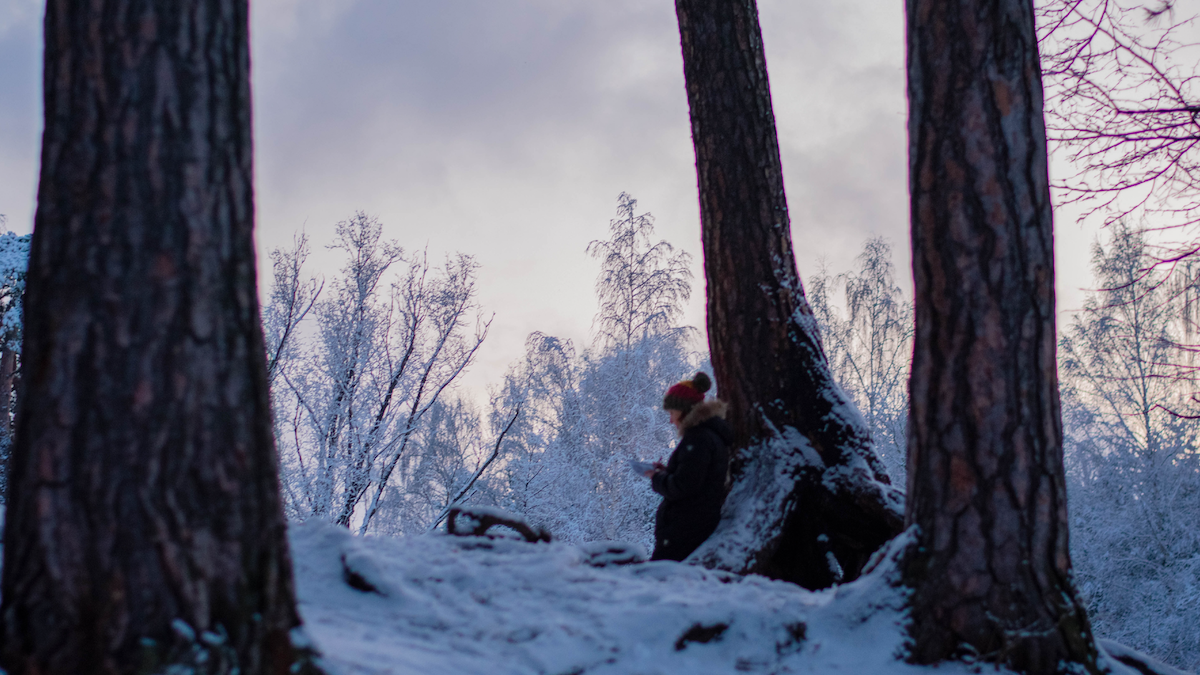I love exploring the woods behind my house in the wintertime. I love the way the wall of green that protects certain areas in the summer lets its guard down for those who are willing to brave the winter cold. I tend to venture into new areas, exploring the hidden hollows and dark thickets that normally escape my awareness.
Winter seems to encourage us all to go inward and explore the mysterious places, creating a deep and intimate connection that summer is too fast to find. Many things go internal during the winter and the forest has a feeling of being asleep. It can be rare to find a creature moving around out there in the winter, so our interactions can be limited. That is why one of my favorite natural beings to connect with in winter are the trees.
What an amazing idea they came up with to grow their cells into a hard but flexible skeleton of wood. Just like the little green plants, they send most of their energy and water down into their roots, but their bark and branches are still there for us to explore. I love trees and can spend hours wandering through them or climbing in their branches. For most of the year, I feel like I know them all by their flowers, leaves, and fruits and sometimes from a great distance. So in the winter, I get excited to test my knowledge of these cherished friends and see just how well I really know them.
At first, these tests were not very encouraging. When I started my journey as an obsessed naturalist, I lived in Ohio, amongst the beautiful trees of the eastern deciduous forest. The winters brought drastic changes to the forest as there are few evergreen trees. I can remember the old-growth forest I lived so close to was full of American Beech and Sugar Maple.
Of course, there were many other kinds of trees as well, but in the winter there was the American Beech, easy to identify by their smooth gray bark, and then there were the other trees with rough bark, mostly Sugar Maples. It can be difficult at first to learn to identify trees by their bark. The key, as with most overwhelming tasks, is to find a place to start.
My favorite place to start is with the easy ones because it helps to build my confidence. In Ohio, I started with the beech trees and the Shagbark Hickories. When I moved out to the Pacific Northwest I started with the Big Leaf Maples and the Black Cottonwoods. Every area is bound to have some trees with a really distinct bark.
Ideally, you can find a guided hike with a naturalist to point out some easy ones for you or visit an arboretum where the trees are labeled, as it is difficult to use a field guide when all you are working with is the bark. If your only option is the field guide, try to look them up in an Audubon guide, which tends to have photos of the bark. Realize that the photos are usually of one individual tree—I have found that trees vary significantly based on age and region.
Of course, the best teacher is the trees themselves. They know quite well who they are, but the trick is figuring out how to let them teach you. The best way I know to do this is to get to know them as individuals.
Start with a tree in your Sit Spot. You know the one you rest your back against, and whose roots sometimes make your butt sore. Next time you are sitting and you have one of those moments where you cannot stop thinking about your warm house and you begin doubting Jon Young’s stories, “He didn’t really sit in his backyard every day, he probably has no clue what the birds are saying, I haven’t even seen a bird since I got out here four minutes ago.”
This is just the right moment to stop trying to sense meditate, or be thankful, and check out your old friend’s bark. Just turn around and look closely, breathe in its scent, and feel it with your fingertips. Pretend you are an ant crawling up the trunk and explore the surface of the bark like a great adventurer. Once you are familiar with the bark of your old friend then you can start looking for it elsewhere. Hopefully, you already know the name of this tree. If not, the good thing about trees is they tend to stay in one place, so you have all year to look for clues.
Once you are done exploring the first tree move on to others, especially the familiar ones. Before long you will start to see familiar bark on trees in places outside your sit spot area. In the summer we are usually distracted by the leaves, which is often the easiest way to identify a tree. So take advantage of the winter to get familiar with the bark, even if you cannot identify the trees right away.
I remember one winter I fell in love with the bark of a tree that I thought looked like a miniature version of the Grand Canyon. Once I was familiar with it, I started noticing it was really common in the woods all over my park. That summer I was delighted to find that it was some type of elm and poured through the field guides to learn its name. To this day, Hackberries are still one of my favorite trees and I cannot pass by one without tracing its bark with my fingers.
